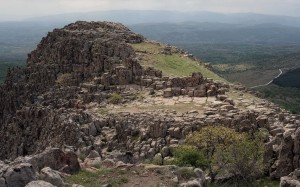Now for something different. Older. Cooler. Rockier.
In 2001 CE, archaeologist Jovica Stankovski discovered a site that dated to the Bronze Age (roughly 1800-1600 BCE for Central Europe) near the village of Kokino in the Republic of Macedonia.* Near the top of the site, terracotta objects dating to 1800 BCE were discovered in a naturally formed stone “room.” Even more interesting that those remnants, however,was the disposition of the volcanic rock around the site. As you can see from the wallpaper linked above, the site occupies multiple levels on a hilltop and consists of both natural and human-made rock formations. In 2002 CE, physicist Gjore Cenev began conducting an archaeo-astronomical analysis of the stones and turned up some interesting results.
In the right-center of the photo, you can see the roughly quadrilateral shapes of stone seats, or “thrones,” that have been crafted and positioned so that they face east. Not readily visible in the image are the stone sets that Cenev argues were used to mark particular days in the solar and lunar calendars. The survey team located three stone markers that indicated the location of the sunrise at the summer and winter solstice, as well as at the vernal and autumn equinoxes. They also located four stone markers that indicated the position of the rising moon on when it was at maximum and minimum declination. Two more stone markers were meant to measure the length of the lunar month in winter and summer.
Across several publications, Cenev has provided a great deal of information about his team’s approach to measurement and analysis (they basically extrapolated from Gerald Hawkins’ work at Stonehenge in the 1960s). That anyone is capable of looking at a pile of stone put together 3800 years ago and figure out what’s going in terms of astronomical observation is amazing enough; that they were able to postulate certain societal behavior from their study is even more so.
For example, Cenev notes that the position of the lunar markers suggests that the Macedonians were aware of the metonic (19-year) cycle of the moon. [Briefly, it takes 19 years before a full moon to appear in exactly the same place again.] However, to gather enough data to determine the metonic cycle conclusively, astronomers would have needed make lunar observations for some 38-57 years. Given a life expectancy of forty years for ancient Macedonians, that means the society assigned enough importance to the calendar to conduct observations for at least two, and probably three, generations.
There’s more to be read in Cenev’s work: a single stone seems to mark the location of the sunrise on a day not obviously associated with the calendar, giving rise to the speculation that the day was important for some ritual or another, probably associated with harvest. The geology of the site is interesting, as the inhabitants took advantage of the local andezite’s tendency to fracture along straight lines, providing them with natural building blocks. At least some of the observation points can be occupied only by a single person. So, while it’s interesting to read about the calendrical calculations and how they compared to those made at Stonehenge, it’s even more intriguing to use the (admittedly fragmented) evidence to try and build a picture of the people who built the observatory at Kokino.
*I used three papers by Gjore Cenev for this post:
Cenev, Gjore. “Archaeo-astronomical characteristicsof the Kokino archaeological site.” Bulgarian Astronomical Journal 9 (2007): 133-1.147
________. “Kokino Calendar.” Publications of the Astronomical Observatory of Belgrade No. 85 (2008): 87 – 94
________. “Megalithic Observatory Kokino.” Publications of the Astronomical Observatory of Belgrade No. 80 (2006): 313-317.
